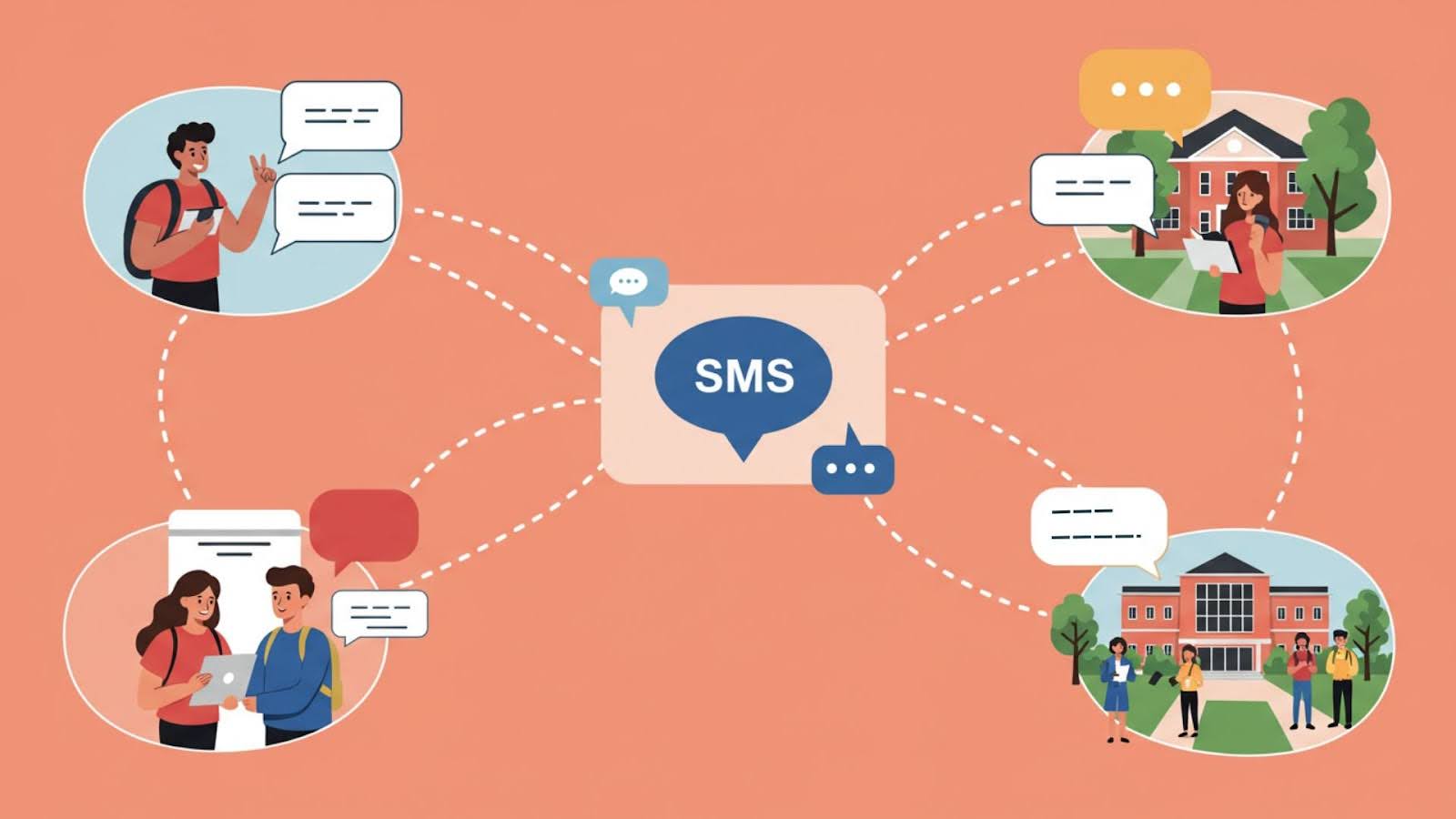The Rise of Higher Education Text Messaging Platforms
The communication revolution in higher education isn't happening in lecture halls; it's happening in students' text messages. While institutions have long relied on traditional channels like email and campus portals, 98% of text messages are read compared to just 20% of emails. This stark difference has prompted colleges and universities to rethink how they connect with students, prospects and alumni.
Higher education texting platforms bridge the communication gap between institutions and their increasingly mobile-first audiences. With 84% of consumers now opting in to receive SMS messages from organizations and Gen Z checking their texts over 20 times daily, the shift toward text-based communication is an essential evolution.
Understanding Higher Education Texting Platforms
Higher education texting platforms represent a specialized category of communication technology designed specifically for the unique needs of college and university students. Unlike generic business SMS tools, these platforms are purpose-built to handle the complex requirements of academic institutions, from FERPA compliance to integration with student information systems.
What Makes Higher Education SMS Different from General Business Texting
The distinction between general business texting tools and higher education texting platforms lies in their specialized features and compliance capabilities. Academic institutions face unique challenges that generic SMS platforms aren't designed to address. Student privacy regulations, complex enrollment processes and the need for sophisticated audience segmentation based on academic status, major or year require purpose-built solutions.
Higher education texting platforms offer advanced personalization capabilities that can segment audiences based on academic progress, financial aid status, housing arrangements or extracurricular involvement.
This level of granular targeting ensures that students receive only the most relevant information, reducing message fatigue and improving engagement rates. FERPA regulations require strict controls over student data and education-specific platforms include built-in safeguards to protect sensitive information while enabling effective communication.
The Technology Behind Campus Communication
Leading higher ed texting platforms leverage sophisticated technology stacks that combine artificial intelligence, machine learning and robust data integration capabilities. AI-powered features enable automated responses to common student inquiries, while machine learning algorithms help optimize message timing and content for maximum engagement.
The backbone of these platforms is their integration capabilities, connecting with Student Information Systems (SIS), Customer Relationship Management (CRM) platforms and other campus technologies to create unified communication ecosystems.
Why Higher Education Institutions Are Embracing Text Messaging
The rapid adoption of text messaging in higher education is driven by measurable results and student preferences that can no longer be ignored. Institutions that have implemented comprehensive texting strategies are seeing dramatic improvements in engagement, enrollment and retention metrics.
The Response Rate Revolution: SMS vs Email Statistics
The numbers tell a compelling story about why institutions are shifting their communication strategies. While email open rates in higher education typically hover around 20%, nearly one-hundred percent of text messages are read compared to email. Even more impressive, SMS messages generate response rates of 45%, compared to email's dismal 6% response rate.

These statistics translate into real-world impact for student engagement initiatives. When the University of Texas at Austin implemented a comprehensive texting strategy, they achieved 98% engagement with their targeted student population.
Meeting Students Where They Are: Mobile-First Communication
Today's college students don't just prefer mobile communication; they expect it. For Gen Z students, who make up an increasing portion of higher education enrollment, texting is their primary mode of interaction.
The mobile-first mindset extends beyond simple preference to accessibility and convenience. Students juggling work, family responsibilities and academic commitments need communication that fits into their busy lives. Rather than expecting students to check multiple email accounts or navigate complex student portals, successful institutions are bringing important information directly to the communication channel students use most naturally.
Essential Features to Look for in Higher Education Texting Platforms
Selecting the right texting platform can make the difference between a communication strategy that transforms student engagement and one that becomes another ignored channel. The most effective platforms combine powerful functionality with user-friendly interfaces that both staff and students can easily navigate.
Two-Way Conversational Messaging and Automation
The most impactful higher ed texting platforms enable genuine conversation between institutions and students. Two-way messaging capabilities allow students to ask questions, request support and engage in meaningful dialogue with staff members, creating opportunities for relationship building that simply aren't possible with traditional communication channels.
Smart automation features enhance these conversational capabilities by automatically handling routine inquiries while escalating complex questions to appropriate staff members. Modern platforms use AI to recognize common question patterns and provide instant responses to frequently asked questions about deadlines, requirements or campus resources, reducing staff workload while providing students with immediate support.
CRM Integration and Student Data Management
The power of higher education texting platforms is fully realized when they integrate seamlessly with existing campus systems. CRM and SIS integration enables platforms to access real-time student data, allowing for dynamic message personalization based on current academic status, enrollment activities or engagement history.
Integration transforms generic messaging into highly targeted communication that speaks directly to each student's specific situation. Instead of sending broad announcements about registration, institutions can send personalized messages that include specific registration dates, course recommendations and next steps based on the student's major, academic standing and degree progress.
Compliance and Security Considerations
In higher education, compliance is fundamental to maintaining student trust and institutional integrity. The most robust texting platforms include built-in compliance features that address both educational privacy regulations and telecommunications laws without requiring extensive manual oversight.
FERPA compliance features ensure that sensitive student information is protected throughout the messaging process, including secure data transmission, access controls and audit trails. TCPA compliance features manage legal requirements around text messaging, including proper opt-in procedures, clear sender identification and easy opt-out mechanisms.
Comparing Popular Higher Education Text Messaging Platforms
The higher education texting platform market offers numerous options, each with distinct strengths and capabilities. Understanding the key differentiators can help institutions identify the solution that best aligns with their specific needs and strategic objectives.

Modern Campus Message leads the market with its revolutionary AI-powered blended messaging technology, which seamlessly combines automated responses with human interaction within single conversation threads. Purpose-built exclusively for higher education institutions, the platform offers deep integration capabilities with existing campus systems and supports comprehensive communication strategies across the entire learner-to-earner lifecycle. Modern Campus's decades of higher education expertise ensure that institutions receive not just a platform, but a strategic partner that understands the unique challenges and opportunities in academic environments.
Element451 focuses primarily on admissions and recruitment use cases as an AI-first CRM platform with SMS capabilities. While their omnichannel approach coordinates text, email, and social media communications effectively, their specialization in prospective student engagement may limit broader institutional communication needs beyond the enrollment funnel. For institutions primarily focused on enrollment marketing and prospect nurturing, Element451 offers strong analytics and campaign tracking capabilities.
TrueDialog provides enterprise-grade SMS solutions designed for high-volume messaging campaigns with strong security features. Their platform works well for institutions primarily seeking basic broadcast messaging capabilities, though organizations requiring more sophisticated conversational engagement may find the platform's automation features less comprehensive. Large universities that need to send thousands of messages simultaneously will appreciate TrueDialog's robust infrastructure and delivery reliability.
SMS Magic offers CRM-based texting solutions with particular strength in Salesforce integration. Their platform serves institutions focused specifically on sales and recruitment activities, though the narrow CRM focus may require additional solutions for comprehensive student lifecycle communication. Organizations already invested in Salesforce ecosystems will find SMS Magic's native integration creates seamless workflow efficiencies.
Ocelot combines basic SMS messaging with chatbot capabilities to provide automated student support. While their pre-built content libraries offer convenience for routine inquiries, institutions seeking more personalized, relationship-building communication may find the chatbot-centric approach limiting for deeper student engagement. Student services teams looking to reduce repetitive inquiry volume will benefit from Ocelot's automated FAQ responses and knowledge base integration.
When evaluating these platforms, institutions should prioritize solutions that offer comprehensive functionality, deep higher education expertise, and the ability to support communication needs across all departments and student populations rather than point solutions that address only specific use cases.
Real-World Applications: How Institutions Use Text Messaging
The versatility of higher education texting platforms enables institutions to address diverse communication challenges across multiple departments and student populations. Successful implementations demonstrate the transformative impact of strategic text messaging on institutional effectiveness and student outcomes.
Student Recruitment and Enrollment Management
Text messaging has revolutionized how institutions manage the complex enrollment funnel, providing unprecedented opportunities to guide prospective students through each step of their decision-making process. Research from the University of Virginia showed that personalized weekly messaging increased enrollment rates by 7%, demonstrating the measurable impact of strategic communication on recruitment outcomes.
The most effective enrollment messaging strategies combine automated nurture campaigns with opportunities for personal interaction. Prospects receive systematic information about programs, campus life and next steps while having access to admissions counselors who can address specific questions and concerns.
Retention and Academic Success Support
Text messaging has emerged as a powerful tool for supporting student persistence and academic achievement, enabling institutions to provide proactive support that addresses challenges before they become barriers to success. The Austin Community College District achieved a 15% increase in persistence among part-time students by using text messaging to share reminders about financial aid deadlines, workshop opportunities and money management resources.
Successful retention messaging programs segment audiences based on factors like academic standing, enrollment status and engagement levels to ensure that each student receives relevant support. The conversational nature of text messaging also enables institutions to identify and address student concerns in real time, helping prevent small challenges from becoming major obstacles to student success.

Alumni Engagement and Development
Text messaging provides alumni relations teams with new opportunities to maintain connections with graduates and support institutional advancement goals. The immediacy and convenience of text messaging make it particularly effective for event communications, donation campaigns and ongoing relationship building with busy alumni who may not regularly check email.
Successful alumni engagement through text messaging focuses on providing value while respecting alumni preferences for communication frequency and content. The key to effective alumni messaging is segmentation based on graduation year, giving history, geographic location and engagement preferences, ensuring that alumni receive communications that are relevant to their interests and capacity.
Implementing a Text Messaging Strategy: Best Practices
Successful text messaging implementation requires careful planning, strategic thinking and adherence to proven best practices that maximize engagement while maintaining compliance and student satisfaction. The most effective implementations combine technological capabilities with thoughtful communication strategies that reflect institutional values and student needs.
Getting Started: Compliance and Opt-In Requirements
The foundation of any successful text messaging program is a robust compliance framework that protects both the institution and its students while enabling effective communication. Proper opt-in procedures are essential for both legal compliance and building trust with students who need to understand how their information will be used.
Effective opt-in strategies make the value proposition clear while providing students with control over their communication preferences. Rather than simply asking for permission to send text messages, successful institutions explain what types of messages students will receive, how frequently they'll be contacted and how the messaging will support their academic success.
Crafting Effective Messages That Drive Action
The effectiveness of text messaging campaigns depends heavily on message quality and strategic timing. Successful messages are concise, personalized and action-oriented, providing students with clear information about what they need to do and why it matters for their success.
The most engaging messages combine institutional information with personal relevance, helping students understand how general requirements or opportunities apply to their specific situation. Message timing is equally important as content quality, with successful institutions using data analytics to identify optimal sending times and coordinate messaging across departments to prevent communication fatigue.
Transform Your Institution's Communication Strategy
Higher education texting platforms have moved from optional nice-to-have technology to essential infrastructure for effective student communication. Institutions that embrace strategic text messaging are seeing measurable improvements in enrollment, engagement and retention, while those that rely solely on traditional communication channels are missing opportunities to connect with increasingly mobile-first student populations.
Modern Campus has been pioneering this transformation through our comprehensive learner-to-earner lifecycle platform that powers solutions for student engagement and communication across the entire educational journey. Our AI-powered Message platform combines sophisticated automation with genuine human connection, enabling institutions to scale personalized communication while maintaining the authentic relationships that drive student success. Request a demo today to explore how Modern Campus can help you build stronger connections with your learners for life.
Frequently Asked Questions
What is the average response rate for higher education text messaging? Higher education text messaging typically achieves response rates of 45%, which is significantly higher than email response rates of approximately 6%. The high engagement is driven by the immediate nature of text messaging and students' preference for mobile communication channels.
How do institutions ensure FERPA compliance with text messaging? FERPA compliance in text messaging requires using platforms with built-in privacy protections, limiting the sharing of sensitive student information via SMS, implementing proper access controls and maintaining audit trails of all communications. Institutions should also provide staff training on what information can appropriately be shared through text messaging.
What's the ROI of implementing a text messaging platform? ROI varies by institution and implementation scope, but many colleges report measurable improvements in enrollment conversion, student retention and operational efficiency. Some institutions see enrollment increases of 7% and retention improvements of 15% through strategic text messaging programs, with relatively low implementation costs compared to other engagement technologies.
How do students prefer to receive communications from their institutions? Current research shows that 84% of consumers opted in to receive text messages from organizations, with Gen Z students showing particularly strong preferences for text-based communication. Students prefer text messaging for time-sensitive information, deadlines and quick updates while still valuing email for detailed information and official documentation.
Last updated: July 22, 2025



